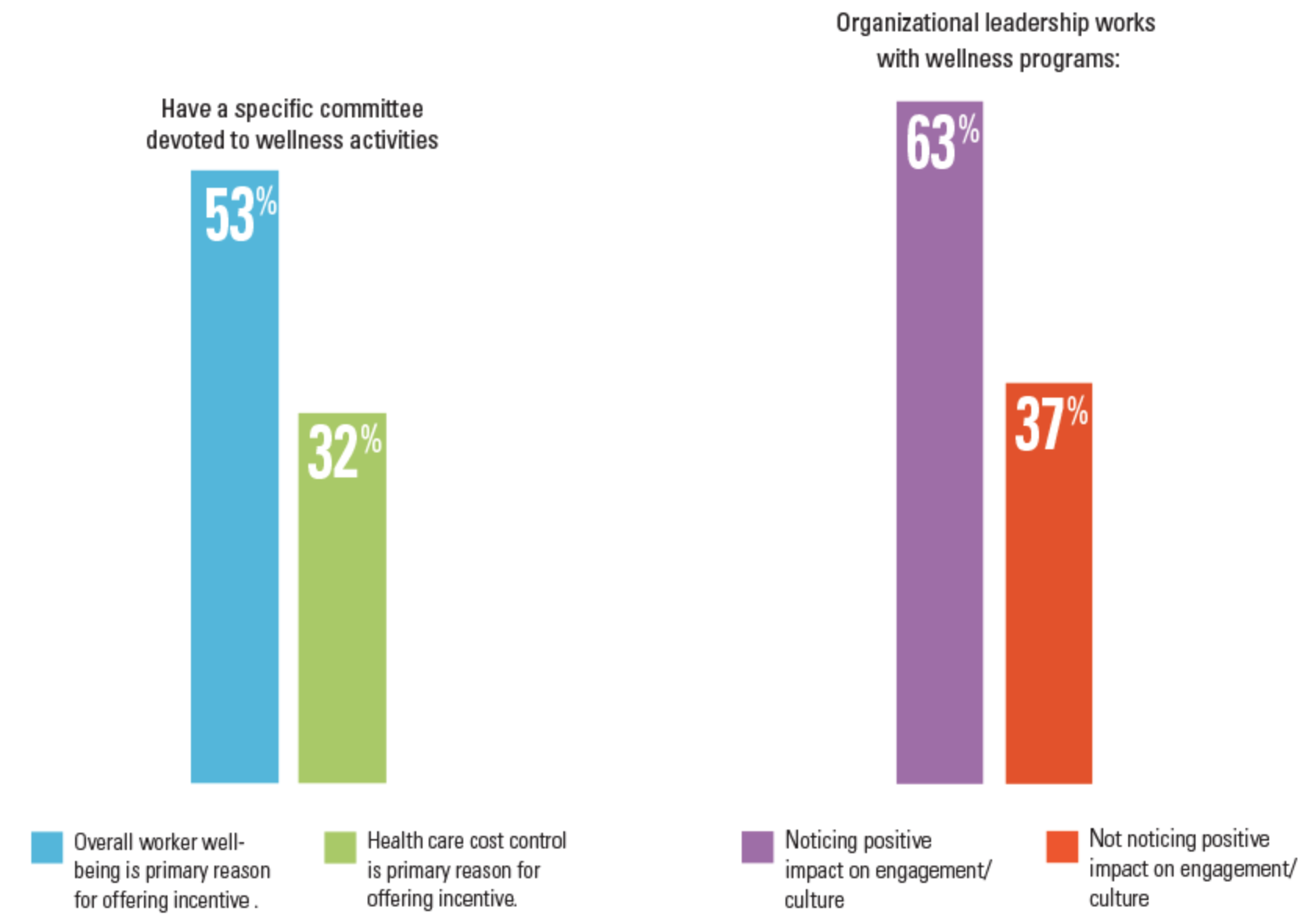Importance Of Employee Health In The Workplace
Corporate wellness programs have existed since the late 1800s and have undergone significant changes over time. However, interest in these programs has recently skyrocketed, particularly post-pandemic.
What was once considered a “nice-to-have” perk has now evolved into a “must-have” benefit for employers looking to attract and retain top talent in a competitive job market. To keep employees content and maximize their performance, taking a holistic approach to employee health is essential. Consider the process of growing a garden, where sunlight, water, and nutrients each play an irreplaceable role in the plants’ abilities to thrive. In the same way, employers must address all dimensions of employees’ well-being for them to flourish.

Despite the majority of companies offering wellness benefits, many still struggle to help employees lead healthy lives. The obesity rate in the US has been rising over the past three decades, with all states at above 20% in 2018. This poses significant health risks, such as heart disease, cancer, stroke, diabetes, and other conditions. Mental health is another increasingly significant medical concern, with more than one-in-five adults experiencing mental illness each year.
Although corporate wellness programs can effectively improve employee health, these statistics suggest that they should not be solely relied upon as a solution. If companies want to develop and sustain a community of healthy employees, they must go beyond a “check-the-box” approach by creating a culture of health in the workplace.
Pressed for time? Here’s a quick summary…
- Culture of health defined: A culture of health in the workplace involves prioritizing and promoting healthy behaviors through policies, practices, and norms that support employee well-being.
- Benefits: A culture of health yields organizational success by reducing costs associated with lost productivity, improving employee performance and satisfaction, serving as a talent acquisition and retention tool, and fostering a positive work culture.
- Action steps: Building a culture of health in the workplace is an ongoing process that includes aligning business practices with well-being, prioritizing effective communication, implementing a tailored wellness program, and more.
What Is A Culture Of Health?
Every organization has its own unique culture, which encompasses the shared values, beliefs, behaviors, work processes, and practices of its employees. The same definition can be applied to a culture of health.
Building a culture of health in the workplace means creating an environment that prioritizes and encourages healthy behaviors, while demonstrating a deep commitment to improving employee health and well-being. This requires policies, practices, and norms that actively support and promote healthy habits, both at work and beyond.

In some companies, there can be a disconnect between the stated culture and the actual practices and norms. Imagine Company A, which says it is family-friendly, has a remote working policy and a wellness program in place, but…
- Employees rarely take advantage of it because they fear missing out on an in-office meeting.
- There may be a maternity or paternity benefit after the birth or adoption of a child, but employees don’t take the entire allotment because it might be viewed as a lack of dedication to the job.
- Team leaders often text employees on weekends and expect a response.
Even if Company A has a formal wellness program, it does not have a culture of health.
Contrast this with Company B, which also has a flexible working policy and a wellness program, and…
- Most employees choose to work from home several days during the month.
- Employees with young children particularly enjoy the ability to work remotely when they have a sick child at home.
- The organization uses technology so meetings can be conducted online.
- The team leader encourages vacationing employees to turn off work emails, and the CEO has a policy to leave the office every day by six o’clock.
The actions of Company B clearly reflect the culture’s focus on well-being, indicating that it has successfully established a culture of health.
A culture of health in the workplace extends beyond the implementation of a wellness program and is broader than any individual wellness program component. It is not the same as providing office perks or paying employees to participate in wellness programs. A culture of wellness includes the systems of support (i.e., the technology to work remotely, vacation policies, and leadership by example) to develop a foundation that emphasizes well-being.
A company that does not currently have a culture of health has the power to pivot towards prioritizing employee well-being at any time. Culture is fluid and can always be improved upon.
Organizational Benefits Of A Culture Of Health In The Workplace
Research indicates that well-being closely relates to key health outcomes such as reductions in healthcare utilization, obesity status, and the occurrence of chronic diseases. By building a culture of health in the workplace, employers can significantly boost workforce well-being, not only serving the health interests of employees but also propelling organizational success.
Reduces Absenteeism & Presenteeism

Healthy employees are less likely to miss work or perform below their capacity due to illness (presenteeism). This directly translates to improved productivity and performance, ensuring that the organization operates at its full potential.
A focus on health reduces the economic burden on employers caused by unwell employees, who can significantly impact innovation, creativity, and engagement due to absenteeism and presenteeism.
Boosts Bottom Line
Employee well-being is a predictor of numerous business outcomes, such as employee engagement, customer engagement, turnover, and workplace safety, which can affect a company’s ability to reach its economic potential.
Increases Talent Retention & Attraction

Potential and current employees (particularly millennials) look for companies that care about employee well-being. Building a culture of health demonstrates that the company authentically cares about its employees, and the meaningful benefits associated with this culture are a useful retention tool.
Cultivates A Positive Workplace Culture

Establishing culture of health serves as a catalyst for a positive, engaging work environment. Social network theory provides a framework for understanding its impact. This theory examines how environmental factors personal health behaviors, such as following a healthy diet, exercising, and using tobacco.
One pivotal study found that obesity can spread through social ties—the chances of becoming obese increased when study participants had family or friends who became obese. Researchers suggest that when those in a social network are obese, it may feel natural and not concerning for others to gain weight.
This theory extends beyond physical health. Another study shows that happiness can spread in social networks up to three degrees of separation (i.e., a friend of one’s friend’s friends can affect their level of happiness).
By building a culture of health, organizations can leverage the power of social networks to amplify positive behaviors. This not only encourages employees to lead healthier lives but also cultivates a positive, supportive work culture.
Heightens Participation Rates & Employee Satisfaction

Companies that normalize a culture of health require fewer financial incentives to encourage participation, saving money on rewards and incentives. These companies also reported higher participation rates in wellness programs and increased levels of employee satisfaction and well-being. Most impressively, employees from those companies have a sense of responsibility to take care of their health, which is a prerequisite to making any sustainable change.
For companies already investing in wellness initiatives, building a culture of health is the best way to make the most out of the investment.
How To Create A Culture Of Health
A culture of health must be integrated into the day-to-day operations, practices, and policies of an organization.
1. Align Business Practices With Well-Being
Environment
The workspace environment has a profound impact on employee productivity and well-being. Greening the office with indoor plants, for example, has been shown to increase productivity by 15%, along with a host of benefits, including boosting mood, elevating creativity, and improving air quality.

If budgets allow, offer employees the ability to customize their workspace. Different types of chairs, keyboards, standing desks, or treadmill desks can create a healthier workplace environment. Additionally, a diverse environment with different spaces optimized for social interaction, relaxation, collaboration, and concentration will keep employees mentally healthy and happy at work.
Office snacks are a fabulous perk that can provide employees with a boost of energy during the afternoon slump. However, unhealthy snack options often dominate break room cabinets. Try replacing the chips, cookies, and cheesy puffs with healthier options. Many services can deliver fresh fruit and other nutritious snacks directly to the office, making it effortless to provide healthy choices.
Events
Pizza is often the go-to meal choice for a working lunch or a celebration of a team accomplishment. While inexpensive, efficient, and widely liked, it is not the most nutritious food option. Consider ordering wraps, salads, or other healthy meals for work meetings and events.

A work happy hour is a fun way to de-stress and connect with employees in a casual setting. Don’t do away with happy hours but consider adding a few health- or physical-activity-focused events to the social calendar. Employee team-building can take place over smoothies, bowling, or laser tag. Managers can work with their teams to plan group fitness activities like a lunchtime run or sunset hike.
Policies
Overworking employees can lead to burnout and have negative health implications. A summer Friday half-day can go a long way in rejuvenating employees after a busy week. Providing employees with ample vacation time and flexible work arrangements can help make a demanding job more manageable. It’s easy for employers to offer vacation days, but it’s more challenging to establish a culture where employees feel comfortable taking advantage of the policy. Encouraging employees to use vacation time is vital; senior leaders must lead by example.

A more flexible dress code may make it easier for some employees to go for a mid-day walk or attend an exercise class after work. While flexible dress policies aren’t feasible for every organization, they can help some companies promote a healthier work culture.
2. Leverage Leadership Involvement
Leaders must “walk the talk” — in other words, they must participate in developing a culture of health in the workplace. That may mean leaving the office by five o’clock to emphasize work-life balance or establishing a remote work policy for employees. If leaders do not act as role models, the culture cannot be reinforced.
Leaders should also “talk the talk” by intentionally communicating about their actions, how those actions create a culture of wellness, and why they are essential for the well-being of employees.
The influence of leaders can’t be overstated. When leaders of organizations with top-scoring wellness programs publicly recognized employees for healthy actions and outcomes, employees had more health improvements (91% vs. 83%) and medical improvements (87% vs. 81%) than in organizations where there was no public leadership recognition.
Leaders are not just the ones in the C-suite. They can be mid-level or front-line managers or anyone who supervises employees and makes decisions that impact an employee’s job, flexibility, and health. In many cases, the mid-level and front-line leaders may have more interaction with employees than the senior leaders, so leaders at every level must support and model wellness for it to become part of the company’s culture.
Leaders can influence employees’ commitment to wellness by recognizing those who exhibit healthy behaviors. An email blast to the company highlighting the employee’s success, inviting program participants to a healthy lunch, and giving monetary and non-monetary awards can help spur participation.
3. Implement A Tailored Wellness Program
A culture of health in the workplace should include a tailored wellness program designed for the employees it is meant to serve. Too often, employees do not participate in wellness programs because those offerings do not match their specific needs. Just as a diverse garden requires recognizing the needs of each plant and treating them accordingly, each employee has unique needs that must be addressed in a tailored wellness program.
These needs can differ for employees depending on their geographic locations, job functions, and demographics. This is why a wellness initiative should provide a holistic array of options to make the most impact. Find out what employees want by asking what is working and what isn’t. Use surveys to get feedback and build upon what is already effective.
4. Prioritize Mental Health
Mental health is an essential dimension of well-being. Leading companies continue to recognize the importance of providing mental health benefits for their employees, with 91% of employers increasing investments in this area this year.
Mental health has been at the forefront of employee benefits since the pandemic and is a win-win situation for both employees and employers. Not only does it boost employee well-being, job satisfaction, and morale, but it also increases productivity and engagement while reducing absenteeism. Employers prioritizing mental health also demonstrate their commitment to providing quality care and have an edge in attracting and retaining top talent.

Mental health benefits create a safe and supportive environment for employees to discuss their concerns while reducing the stigma associated with taboo topics. Benefits can range from sessions about parenting skills and budgeting to stress-management workshops and healthy cooking classes.
It is important to note that misguided attempts to foster company culture could produce the opposite effects from the desired outcome. For example, mandatory fun events inhibit flexibility and choice, so it is best to make these optional. Educational seminars are helpful complementary pieces of a holistic wellness program. However, they are not a replacement for PTO, mental health days, or other policies that give employees time to relax and recharge. Branding a business as a “family” is usually an attempt to cultivate bonds between employees. However, the majority of working professionals feel that the family brand is not likely to help an organization run better. Workplace “teams” or “crews” offer suitable alternative frameworks.
5. Practice Effective Communication
A wellness program is ineffective if employees don’t know it exists. Yet, one study indicated that only 16% of employees strongly agreed that they knew where to find the health and well-being resources offered to them.

Conclusion
Companies are increasingly recognizing the importance of employee wellness, but it is vital to remember that creating a culture of health is not a trend or a matter of “checking a box.” A genuine culture of health in the workplace arises from employers who care about their employees’ well-being and understand the necessity of a healthy workforce for the mutual success of the employees and the organization.

With a commitment to employees’ wellness, demonstrated through ongoing actions taken throughout the organization, a culture of health can cultivate and sustain a healthy and happy workforce.
This article was last updated on December 28, 2023















